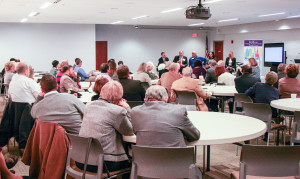
 More than 85 CMT members, regional stakeholders and interested citizens explored ways to further unify the St. Louis community through the growth of the region’s public transit system at the CMT’s Panel Discussion: “Unifying a Region through TRansit Growth.” Special thanks to CMT’s sponsors including BJC Healthcare, DCM Group, and the St. Louis Regional Chamber.
More than 85 CMT members, regional stakeholders and interested citizens explored ways to further unify the St. Louis community through the growth of the region’s public transit system at the CMT’s Panel Discussion: “Unifying a Region through TRansit Growth.” Special thanks to CMT’s sponsors including BJC Healthcare, DCM Group, and the St. Louis Regional Chamber.
In late Spring, 2017, elected officials, local stakeholders and community members created a collaborative network to address issues of declining ridership on public transit, including exploring ways to enhance security on the system. This collaboration led to the first multi-jurisdictional Memorandum of Understanding that was signed by local elected leaders in MO and Il, and by the CEO of Bi-State. The MOU laid out various action items, including the establishment of a transit advisory working group, a joint command center for delivery of security services, and a call for a robust safety audit of the system. The establishment of the MOU was ground-breaking in that in created a framework for all parties to work collaboratively toward the goal of enhancing safety for public transit riders.
CMT Board Chair Rose Windmiller moderated the panel discussion. Windmiller opened the program, “CMT seeks to expand on this concept of collective action initiated around safety and security. Our panelists, each with a distinct area of expertise, will describe ways that transit can be a catalyst for positive change. We will explore the following questions – how can we work together, as a community, to strengthen our current public transit system? How are transit funding and operations’ decisions made? How can stakeholders influence this process, and how can we drive scarce public transit resources in the most equitable manner?”
Dan Meyers, transportation consultant at AECOM, provided an update on the light rail planning and design efforts on the Northside/Southside study. “There is a demand for transit in this area and there is a need for transit,” stated Meyers. “Proportionally, more study area residents use transit to commute and don’t have access to a car, compared to residents across the city and region. We’re trying to connect people to jobs.”
Following the update, the following regional thought leaders outlined transit’s impact beyond the trip from point a to point B.
- Bethany Johnson Javois, Chief Executive Officer of the Integrated Health Network, focused on how responsive public transit positively affects community health. IHN serves the region’s safety net health care providers and the local community to promote the mission of providing quality, affordable, accessible care to all with an emphasis on supporting underserved populations. In addition, Bethany served as Managing Director of the Ferguson Commission, and created the astounding framework for the final report, Forward Through Ferguson: A Path Toward Racial Equity. “Responsive public transit really is in everyone’s best health,” said Johnson-Javois. “You can acheive equity by looking at the issue through the lens of targeted universalism. When you fix it for one, you fix it for all.”
- Rudy Nickens, Director of Equal Opportunity for the MO Department of Transportation, shared his thoughts on how MoDOT addresses equity issues within management framework of his organization. He is an expert in cultural diversity and racial equity, and is an experienced facilitator, educator and entrepreneur. Rudy served as a loaned executive to the Ferguson Commission.“Equity is actually a really important lens through which we focus our work,” said Nickens. “Any discussion about improving transportation infrastructure must include discussions around structural racial equity. St. Louis ranks 19th in the country in terms of population. But it ranks only 68th in terms of transit coverage and access to jobs by transit”.
- Jim Wild, the executive director of the East‐West Gateway Council of Governments, discussed the opportunities for regional collaboration for transit and the process to move a vision forward. East‐West Gateway oversees $ 900 million annually in federal funding for transportation and othe regional projects. Wild stated that regional collaboration among local governments is one of his highest priorities so that financially constrained municipalities and counties can better serve their citizens.Wild offered advice for those looking to advance transit related projects. “What I’m going to suggest is whoever is pushing for transit projects, whether it’s lighting, heating or something else, work with a project sponsor, a city, a county or whomever to piggy back off another project that’s already in the mix to which your project can add some value. We need to focus on moving people and not just moving cars.”
East-West Gateway Presentation